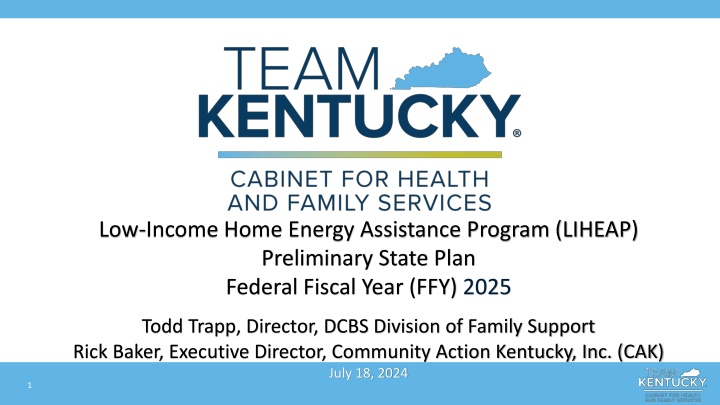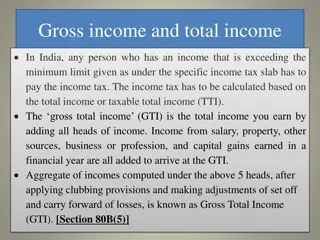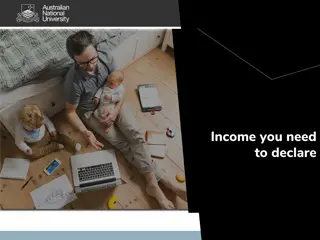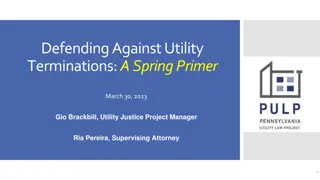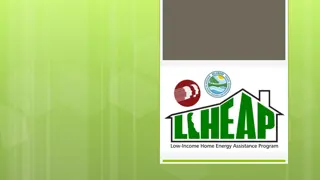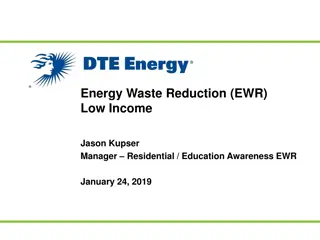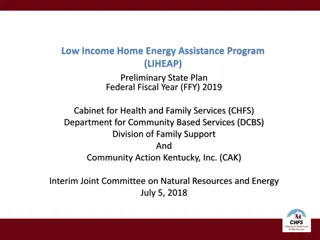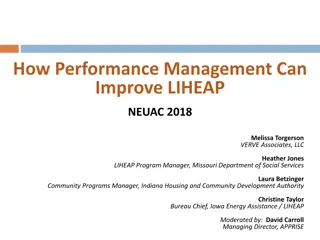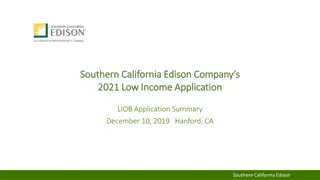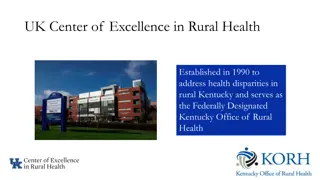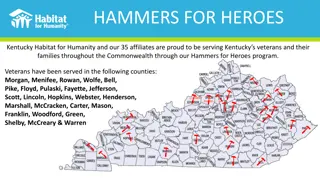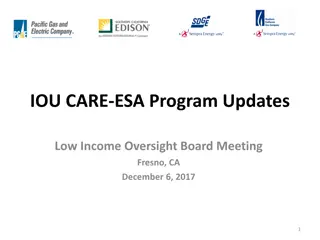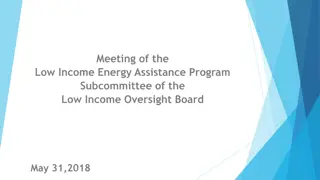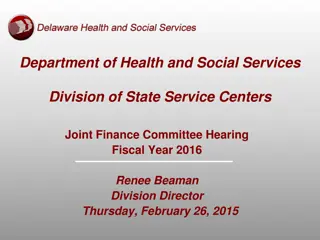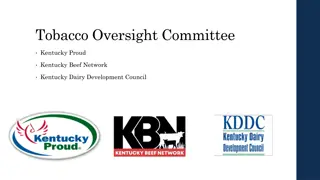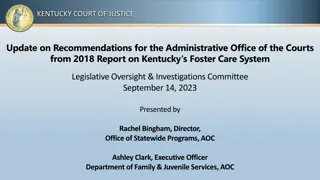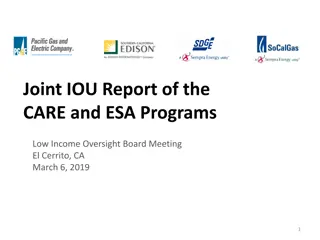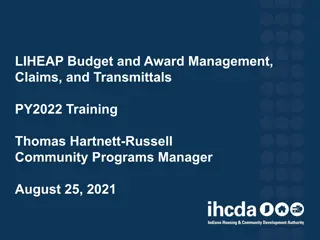Low-Income Home Energy Assistance Program (LIHEAP) in Kentucky
Explore the Low-Income Home Energy Assistance Program (LIHEAP) in Kentucky, providing bill payment assistance, emergency aid, and weatherization activities for eligible low-income households. Learn about the program's history, eligibility requirements, benefits, and subsidy components.
Download Presentation

Please find below an Image/Link to download the presentation.
The content on the website is provided AS IS for your information and personal use only. It may not be sold, licensed, or shared on other websites without obtaining consent from the author.If you encounter any issues during the download, it is possible that the publisher has removed the file from their server.
You are allowed to download the files provided on this website for personal or commercial use, subject to the condition that they are used lawfully. All files are the property of their respective owners.
The content on the website is provided AS IS for your information and personal use only. It may not be sold, licensed, or shared on other websites without obtaining consent from the author.
E N D
Presentation Transcript
Low-Income Home Energy Assistance Program (LIHEAP) Preliminary State Plan Federal Fiscal Year (FFY) 2025 Todd Trapp, Director, DCBS Division of Family Support Rick Baker, Executive Director, Community Action Kentucky, Inc. (CAK) July 18, 2024 1
HISTORY LIHEAP Established in 1982 Safety net program focusing on energy conservation and heating and cooling Meets immediate home energy needs Designed to help households with the lowest incomes that pay a high proportion of income for home energy LIHEAP funds spent in SFY 24 was $47 million Estimated amount of funding for FFY 2025 is $58 million 100% federally funded Low Income Home Energy Assistance Program (LIHEAP) 2
LIHEAP HISTORY $400,000 is retained by DCBS for the Preventive Assistance Program to assist families receiving child protective services with a needed energy payment Up to 15% of the amount can be allocated for weatherization Up to 10% of the amount can be used for administrative costs Low Income Home Energy Assistance Program (LIHEAP) 3
Eligibility Requirement: Low-Income 150% of the Federal Poverty Guidelines (percent of poverty) Household Size Monthly Income 1 $1,823 2 $2,465 3 $3,108 4 $ 3,750 5 $ 4,393 6 $ 5,035 7 $ 5,678 8 $ 6,320 For each additional household member above 8, add $643 to the monthly income limit. 4
Benefits LIHEAP offers the following types of benefits to Kentucky citizens: Bill payment assistance year-round for heating and cooling: - Subsidy component - Crisis component Emergency assistance Weatherization activities to increase the energy efficiency, health, and safety of eligible low-income individual s dwellings Low Income Home Energy Assistance Program (LIHEAP) 5
Subsidy LIHEAP Heating Subsidy Component: Offsets home heating costs Has benefit amounts structured by a percentage of the household s annual heating costs and percentage of poverty met by the household Application process runs early November through Mid- December - Early applications accepted in October for the elderly and individuals with disabilities - Appointments are available for working individuals Low Income Home Energy Assistance Program (LIHEAP) 6
Crisis LIHEAP Heating Crisis Component: Offers assistance for an energy emergency Application process runs from January through March 31 Benefits are limited to the amount necessary to relieve the crisis, with the maximum amount not to exceed Community Action Agency s local cost for a deliverable supply of household s primary heating fuel or $400 for gas or electric Low Income Home Energy Assistance Program (LIHEAP) 7
Subsidy LIHEAP Cooling Subsidy Offsets home cooling costs Assistance amounts are structured according to a percentage of the household s annual cooling costs and percentage of poverty level met by the household Application period was open from April through May, 2024 Low Income Home Energy Assistance Program (LIHEAP) 8
State Fiscal Year 2024 46,972 households received cooling subsidy benefits -Average benefit $142.92 -Total of $6.7M 104,639 households received heating crisis benefits -Average benefit: $244.44 -Total of $25.5 million 71,494 households received heating subsidy benefits -Average benefit: $136.12 -Total $9.7 million Low Income Home Energy Assistance Program (LIHEAP) 9
Weatherization Program Funds home repairs related to energy efficiency Serves low-income households if income does not exceed 200% of the Federal Poverty Guidelines Low Income Home Energy Assistance Program (LIHEAP) 10
Weatherization Program Prioritizes Households containing elderly, disabled, or children Households with young children at risk of removal from the home due to substandard conditions High energy burden households, where the energy costs exceed 15% or more of the household s income Low Income Home Energy Assistance Program (LIHEAP) 11
Weatherization Program Weatherization Program includes activities to increase the energy efficiency and reduce heating costs of dwellings: Installing insulation Sealing air infiltration Heating system or water heater repair Low Income Home Energy Assistance Program (LIHEAP) 12
Weatherization Program Improve the health and safety of the dwelling and heating systems: Testing for gas leaks, carbon monoxide, and other health and safety issues Checking combustible appliances, such as stoves, furnaces, and water heaters Installing fire and carbon monoxide detectors Energy education prioritizes households containing elderly, disabled, or children One hundred and sixty-five (165) homes were weatherized between July 1 and December 31, 2023, with an average benefit of $7,985 using a combination of Division of Energy (DOE) and LIHEAP funds. Low Income Home Energy Assistance Program (LIHEAP) 13
Partnerships Low Income Home Energy Assistance Program (LIHEAP) 14
Partnerships Partnership with Community Action Kentucky, Inc. (CAK) and the Kentucky Housing Corporation (KHC) 23 subcontracting agencies Kentucky s Community Action Agencies administer LIHEAP assistance in all Kentucky counties Low Income Home Energy Assistance Program (LIHEAP) 15
CAK employs continuous quality improvement processes, including: Change Committee Manual updates based on technical assistance and monitoring trends for prior year Data collection and analysis Training and technical assistance to the Community Action Network Low Income Home Energy Assistance Program (LIHEAP) 17
Questions? Low Income Home Energy Assistance Program (LIHEAP) 18
